State Estimation in Partially Observable Power Systems via Graph Signal Processing Tools
Abstract
1. Introduction
- It is demonstrated that the voltages in the power system can be represented as smooth graph signals, where the graph Laplacian is the admittance matrix. This result can serve as a foundation for developing new GSP tools for other power systems applications in future research.
- New state estimation methods for PSSE in both DC-PF and AC-PF models are developed. These methods use the graph smoothness of the states, and do not require the full observability of the network. While regularization using the Laplacian quadratic form has been applied in various applications, such as image processing [44,45], principal component analysis (PCA) [46], data classification [47,48], and semisupervised learning on graphs [49,50], it has not been conducted before in the context of unobservable power systems. Additionally, the nonlinear measurement equations in the AC-PF model present a new challenge from a GSP perspective, requiring the incorporation of graphical information in the form of Laplacian regularization into the iterative method. As such, these state estimation methods contribute to the expansion of the GSP toolbox for a wide range of applications.
- A new approach for sensor placement is introduced to optimize the estimation performance. As the mean squared error (MSE) of the estimator depends on the unknown state vector, the minimization of the Cramr–Rao bound (CRB) is utilized instead. This results in a novel approach that can potentially be applied to other applications in the future.
- Numerical simulations on the IEEE 118-bus system are used to validate the merit of the new estimators and the new sensor placement method under different setups, compared to existing pseudo-measurement and matrix completion techniques.
2. Background and Model
2.1. Background: GSP Framework
2.2. DC-PF Model: State Estimation and Observability
- is the active power vector.
- is the system state vector, where is the voltage angle at bus n. In low-observability systems, it is more convenient to delay the assignment of the reference angle (p. 165 in [2]). Thus, includes the angle of the reference bus.
- is zero-mean Gaussian noise with covariance .
- is the measurements matrix, which is determined by the topology of the network, the susceptance of the transmission lines, and the meter locations [6]. In particular, the N rows of associated with the meters on the buses that measure the total power flow of the transmission lines connected to these buses together create the nodal admittance matrix (e.g., see p. 97 in [2]) with the following -th element:where is the set of buses connected to bus k and is the susceptance of , i.e., equals the imaginary part of .
3. GSP Properties of the States
3.1. Theoretical Validation—Output of a Low-Pass Graph Filter
3.2. Experimental Validation in IEEE Systems
4. GSP-WLS Estimator in DC-PF Model
4.1. GSP-WLS Estimator for the Partial Measurement Model
4.2. Remarks
- (1)
- (2)
- Large : At the other extreme, for , the coefficient matrix from (27) satisfies . Thus, in this case, the GSP-WLS estimator from (26) satisfies . This zero estimator can be interpreted as the a priori state estimator, which does not use the observations. Thus, taking too large a value of is unhelpful.
- (3)
- Relation with the pseudo-measurement WLS (pm-WLS) estimator: The pm-WLS estimator for systems that are not fully observable is based on generating pseudo-measurements of typical power injection/consumption values from historical data [1,24]. In this case, the received measurements are processed together with a priori estimated (predicted) states (without the reference bus), , which are assumed to have the error covariance matrix, . The pm-WLS estimator is the maximum a posteriori state estimator [11]:whereIt can be seen that if and , then and the pm-WLS estimator in (29) coincides with the GSP-WLS estimator in (26). Therefore, the proposed GSP-WLS estimator can be interpreted as a special case of the pm-WLS estimator, where the GSP theory provides a mathematical strategy to determine the pseudo-data information. Moreover, in general, the GSP-WLS estimator only requires setting a single scalar parameter, , compared with the pm-WLS estimator, which requires setting both and .
4.3. Estimation of Missing Power Measurements
4.4. Detection of Bad Data in Unobservable Systems
- Largest normalized residual test (LNR) [1]:where the infinity norm of a vector is defined by .
- test with [1]:
- The GFT-based detector from [7] that was developed for the detection of false data injection (FDI) attacks. The GFT-based detection scheme calculates the GFT of an estimated grid state, , and filters the graph’s high-frequency components. By comparing the maximum norm of this outcome with a threshold, it can detect the presence of FDI attacks.
4.5. Optimization of the Sampling Policy
| Algorithm 1 Greedy selection of the measured buses |
Input: (1) Laplacian matrix, , and noise covariance matrix, (2) Number of buses with sensors, q (3) Regularization parameter, Output: Subset of q buses,
|
5. Extension to the AC-PF Model
5.1. Model, State Estimation, and Observability
- is the measurement vector that includes the active and reactive branch power flows and power injections.
- is the measurement function, which is determined by the sensor types and their locations in the network.
- , is the state vector here, where bus 1 is the reference bus, and thus, and is known (e.g., see Chapter 4 in [1]).
5.2. GSP-Based Gauss–Newton Algorithm
| Algorithm 2: Regularized Gauss–Newton (GSP-WLS) |
Input: (1) Laplacian matrix, , and noise covariance matrix, (2) Tuning parameters: , , and number of iterations, l (3) Measurement vector, , and the function, Output: State estimator, |
5.3. Remarks
6. Results
6.1. Simulations Platform and Parameters
- (i)
- Random bus selection policy (rand.)—the measured buses are randomly chosen independently from , where for more than 72 buses only observable systems are taken.
- (ii)
- Experimentally designed sampling (E-design) [38]—the buses are chosen to maximize the smallest singular value of the matrix , where R is set to 48. The basic assumption behind this method (which was suggested in [66] for power systems) is that the measured graph signal (here, the power signal) is an R-bandlimited signal in the graph frequency domain. That is, the GFT of satisfies , , where R is the cutoff frequency. As can be seen in Figure 3, in practice, the R-bandlimitness assumption does not hold for the power signal.
- (iii)
- Minimum CRB (Algorithm 1)—the proposed bus selection policy from Algorithm 1.
6.2. State Estimation and Sampling under the DC-PF Model
- 1.
- The pm-WLS estimator from [11], generated with , and where is randomly chosen from a zero-mean Gaussian distribution with covariance .
- 2.
- 3.
6.3. State Estimation and Sampling under the AC-PF Model
- (1)
- (2)
- The mc method from [5], implemented using Equations (6), (8), (12a), and (12c) from [5], where the low-rank matrix used in this method, composed of the real and the imaginary parts of . In addition, we added to this method the current measurements as inputs (instead of the power flow measurements) for a fair comparison. The implementation was conducted by the SDP solver of CVX [60].
- (3)
- The proposed regularized Gauss–Newton method for implementing the GSP-WLS estimator from Algorithm 2, with the regularization parameters and .
6.4. Detection of Bad Data
7. Discussion
8. Conclusions
Author Contributions
Funding
Data Availability Statement
Conflicts of Interest
Abbreviations
| GSP | Graph signal processing |
| WLS | Weighted least squares |
| PF | Power flow |
| DC | Direct current |
| AC | Alternating current |
| PSSE | Power systems state estimation |
| EMS | Energy management system |
| GFT | Graph Fourier transform |
| DSP | Digital signal processing |
| KKT | Karush–Kuhn–Tucker |
| pm | Pseudo-measurements |
| MSE | Mean squared error |
| CRB | Cramr–Rao bound |
| LNR | Largest normalized residual |
| FDI | False data injection |
| ROC | Receiver operating characteristic |
| GNN | Graph neural network |
References
- Abur, A.; Gomez-Exposito, A. Power System State Estimation: Theory and Implementation; Dekker, M., Ed.; CRC Press: Boca Raton, FL, USA, 2004. [Google Scholar]
- Monticelli, A. State Estimation in Electric Power Systems: A Generalized Approach; Springer: Boston, MA, USA, 1999; pp. 39–61, 91–101, 161–199. [Google Scholar] [CrossRef]
- Mestav, K.R.; Luengo-Rozas, J.; Tong, L. Bayesian State Estimation for Unobservable Distribution Systems via Deep Learning. IEEE Trans. Power Syst. 2019, 34, 4910–4920. [Google Scholar] [CrossRef]
- De Almeida, M.C.; Garcia, A.V.; Asada, E.N. Regularized Least Squares Power System State Estimation. IEEE Trans. Power Syst. 2012, 27, 290–297. [Google Scholar] [CrossRef]
- Donti, P.L.; Liu, Y.; Schmitt, A.J.; Bernstein, A.; Yang, R.; Zhang, Y. Matrix Completion for Low-Observability Voltage Estimation. IEEE Trans. Smart Grid 2020, 11, 2520–2530. [Google Scholar] [CrossRef]
- Kosut, O.; Jia, L.; Thomas, R.J.; Tong, L. Malicious Data Attacks on the Smart Grid. IEEE Trans. Smart Grid 2011, 2, 645–658. [Google Scholar] [CrossRef]
- Drayer, E.; Routtenberg, T. Detection of False Data Injection Attacks in Smart Grids Based on Graph Signal Processing. IEEE Syst. J. 2020, 14, 1886–1896. [Google Scholar] [CrossRef]
- Morgenstern, G.; Routtenberg, T. Structural-constrained Methods for the Identification of Unobservable False Data Injection Attacks in Power Systems. IEEE Access 2022, 10, 94169–94185. [Google Scholar] [CrossRef]
- Buldyrev, S.V.; Parshani, R.; Paul, G.; Stanley, H.E.; Havlin, S. Catastrophic cascade of failures in interdependent networks. Nature 2010, 464, 1025–1028. [Google Scholar] [CrossRef]
- Gao, P.; Wang, M.; Ghiocel, S.G.; Chow, J.H.; Fardanesh, B.; Stefopoulos, G. Missing Data Recovery by Exploiting Low-Dimensionality in Power System Synchrophasor Measurements. IEEE Trans. Power Syst. 2016, 31, 1006–1013. [Google Scholar] [CrossRef]
- Do Coutto Filho, M.B.; Stacchini de Souza, J.C. Forecasting-Aided State Estimation—Part I: Panorama. IEEE Trans. Power Syst. 2009, 24, 1667–1677. [Google Scholar] [CrossRef]
- Clements, K.A. The impact of pseudo-measurements on state estimator accuracy. In Proceedings of the IEEE PES General Meeting, Detroit, MI, USA, 24–28 July 2011; pp. 1–4. [Google Scholar]
- Zhao, J.; Zhang, G.; Dong, Z.Y.; La Scala, M. Robust Forecasting Aided Power System State Estimation Considering State Correlations. IEEE Trans. Smart Grid 2018, 9, 2658–2666. [Google Scholar] [CrossRef]
- Zhao, J.; Gómez-Expósito, A.; Netto, M.; Mili, L.; Abur, A.; Terzija, V.; Kamwa, I.; Pal, B.; Singh, A.K.; Qi, J.; et al. Power System Dynamic State Estimation: Motivations, Definitions, Methodologies, and Future Work. IEEE Trans. Power Syst. 2019, 34, 3188–3198. [Google Scholar] [CrossRef]
- Bhela, S.; Kekatos, V.; Veeramachaneni, S. Enhancing Observability in Distribution Grids Using Smart Meter Data. IEEE Trans. Smart Grid 2018, 9, 5953–5961. [Google Scholar] [CrossRef]
- Xu, B.; Abur, A. Observability Analysis and Measurement Placement for Systems with PMUs. In Proceedings of the IEEE PES Power Systems Conference and Exposition, New York, NY, USA, 10–13 October 2004; Volume 2, pp. 943–946. [Google Scholar] [CrossRef]
- Zamzam, A.S.; Liu, Y.; Bernstein, A. Model-Free State Estimation Using Low-Rank Canonical Polyadic Decomposition. IEEE Contr. Syst. Lett. 2020, 5, 605–610. [Google Scholar] [CrossRef]
- Paramo, G.; Bretas, A.; Meyn, S. Research Trends and Applications of PMUs. Energies 2022, 15, 5329. [Google Scholar] [CrossRef]
- Mestav, K.R.; Tong, L. Learning the Unobservable: High-Resolution State Estimation via Deep Learning. In Proceedings of the 2019 57th Annual Allerton Conference on Communication, Control, and Computing (Allerton), Monticello, IL, USA, 24–27 September 2019; pp. 171–176. [Google Scholar] [CrossRef]
- Zhang, J.; Welch, G.; Bishop, G.; Huang, Z. Reduced Measurement-space Dynamic State Estimation (ReMeDySE) for power systems. In Proceedings of the IEEE Trondheim PowerTech, Trondheim, Norway, 19–23 June 2011; pp. 1–7. [Google Scholar] [CrossRef]
- Wang, W.; Yu, N.; Rahmatian, F.; Pandey, S. Where to Install Distribution Phasor Measurement Units to Obtain Accurate State Estimation Results? In Proceedings of the 2022 IEEE Power & Energy Society General Meeting (PESGM), Denver, CO, USA, 17–21 July 2022; pp. 1–5. [Google Scholar] [CrossRef]
- Zamzam, A.S.; Sidiropoulos, N.D. Physics-Aware Neural Networks for Distribution System State Estimation. IEEE Trans. Power Syst. 2020, 35, 4347–4356. [Google Scholar] [CrossRef]
- Huang, M.; Wei, Z.; Lin, Y. Forecasting-aided State Estimation Based on Deep Learning for Hybrid AC/DC Distribution Systems. Appl. Energy 2022, 306, 118119. [Google Scholar] [CrossRef]
- Do Coutto Filho, M.B.; de Souza, J.C.S.; Schilling, M.T. Generating High Quality Pseudo-Measurements to Keep State Estimation Capabilities. In Proceedings of the IEEE Lausanne Power Tech, Lausanne, Switzerland, 1–5 July 2007; pp. 1829–1834. [Google Scholar] [CrossRef]
- Yaniv, A.; Kumar, P.; Beck, Y. Towards adoption of GNNs for power flow applications in distribution systems. Electr. Power Syst. Res. 2023, 216, 109005. [Google Scholar] [CrossRef]
- Pourali, M.; Mosleh, A. A Functional Sensor Placement Optimization Method for Power Systems Health Monitoring. IEEE Trans. Ind. Appl. 2013, 49, 1711–1719. [Google Scholar] [CrossRef]
- Soltan, S.; Mazauric, D.; Zussman, G. Analysis of Failures in Power Grids. IEEE Control Netw. Syst. 2017, 4, 288–300. [Google Scholar] [CrossRef]
- Deka, D.; Backhaus, S.; Chertkov, M. Estimating Distribution Grid Topologies: A Graphical Learning Based Approach. In Proceedings of the PSCC, Genoa, Italy, 20–24 June 2016. [Google Scholar]
- Grotas, S.; Yakoby, Y.; Gera, I.; Routtenberg, T. Power Systems Topology and State Estimation by Graph Blind Source Separation. IEEE Trans. Signal Process. 2019, 67, 2036–2051. [Google Scholar] [CrossRef]
- Weng, Y.; Negi, R.; Ilić, M.D. Graphical model for state estimation in electric power systems. In Proceedings of the IEEE International Conference on Smart Grid Communications (SmartGridComm), Vancouver, BC, Canada, 21–24 October 2013; pp. 103–108. [Google Scholar]
- Giannakis, G.B.; Kekatos, V.; Gatsis, N.; Kim, S.J.; Zhu, H.; Wollenberg, B.F. Monitoring and Optimization for Power Grids: A Signal Processing Perspective. IEEE Signal Process. Mag. 2013, 30, 107–128. [Google Scholar] [CrossRef]
- Ishizaki, T.; Chakrabortty, A.; Imura, J. Graph-Theoretic Analysis of Power Systems. Proc. IEEE 2018, 106, 931–952. [Google Scholar] [CrossRef]
- Guo, L.; Zhao, C.; Low, S.H. Graph Laplacian Spectrum and Primary Frequency Regulation. In Proceedings of the 2018 IEEE Conference on Decision and Control (CDC), Miami, FL, USA, 17–19 December 2018. [Google Scholar]
- Dvijotham, K.; Van Hentenryck, P.; Chertkov, M.; Misra, S.; Vuffray, M. Graphical Models for Optimal Power Flow. Constraints 2016, 22, 24–49. [Google Scholar] [CrossRef]
- Retiére, N.; Ha, D.T.; Caputo, J.G. Spectral Graph Analysis of the Geometry of Power Flows in Transmission Networks. IEEE Syst. J. 2020, 14, 2736–2747. [Google Scholar] [CrossRef]
- Sandryhaila, A.; Moura, J.M.F. Discrete Signal Processing on Graphs. IEEE Trans. Signal Process. 2013, 61, 1644–1656. [Google Scholar] [CrossRef]
- Shuman, D.I.; Narang, S.K.; Frossard, P.; Ortega, A.; Vandergheynst, P. The Emerging Field of Signal Processing on Graphs: Extending High-dimensional Data Analysis to Networks and Other Irregular Domains. IEEE Signal Process. Mag. 2013, 30, 83–98. [Google Scholar] [CrossRef]
- Chen, S.; Varma, R.; Sandryhaila, A.; Kovačević, J. Discrete Signal Processing on Graphs: Sampling Theory. IEEE Trans. Signal Process. 2015, 63, 6510–6523. [Google Scholar] [CrossRef]
- Marques, A.G.; Segarra, S.; Leus, G.; Ribeiro, A. Sampling of Graph Signals with Successive Local Aggregations. IEEE Trans. Signal Process. 2016, 64, 1832–1843. [Google Scholar] [CrossRef]
- Ramakrishna, R.; Scaglione, A. Grid-Graph Signal Processing (Grid-GSP): A Graph Signal Processing Framework for the Power Grid. IEEE Trans. Signal Process. 2021, 69, 2725–2739. [Google Scholar] [CrossRef]
- Dabush, L.; Routtenberg, T. Detection of False Data Injection Attacks in Unobservable Power Systems by Laplacian Regularization. In Proceedings of the 2022 IEEE 12th Sensor Array and Multichannel Signal Processing Workshop (SAM), Trondheim, Norway, 20–23 June 2022. [Google Scholar]
- Hasnat, M.A.; Rahnamay-Naeini, M. A Graph Signal Processing Framework for Detecting and Locating Cyber and Physical Stresses in Smart Grids. IEEE Trans. Smart Grid 2022, 13, 3688–3699. [Google Scholar] [CrossRef]
- Saha, S.S.; Scaglione, A.; Ramakrishna, R.; Johnson, N.G. Distribution Systems AC State Estimation via Sparse AMI Data Using Graph Signal Processing. IEEE Trans. Smart Grid 2022, 13, 3636–3649. [Google Scholar] [CrossRef]
- Zheng, M.; Bu, J.; Chen, C.; Wang, C.; Zhang, L.; Qiu, G.; Cai, D. Graph Regularized Sparse Coding for Image Representation. IEEE Trans. Image Process. 2011, 20, 1327–1336. [Google Scholar] [CrossRef] [PubMed]
- Elmoataz, A.; Lezoray, O.; Bougleux, S. Nonlocal Discrete Regularization on Weighted Graphs: A Framework for Image and Manifold Processing. IEEE Trans. Image Process. 2008, 17, 1047–1060. [Google Scholar] [CrossRef] [PubMed]
- Shahid, N.; Kalofolias, V.; Bresson, X.; Bronstein, M.; Vandergheynst, P. Robust principal component analysis on graphs. In Proceedings of the IEEE International Conference on Computer Vision, Santiago, Chile, 7–13 December 2015; pp. 2812–2820. [Google Scholar]
- Wang, F.; Zhang, C. Label propagation through linear neighborhoods. IEEE Trans. Knowl. Data Eng. 2007, 20, 55–67. [Google Scholar] [CrossRef]
- Belkin, M.; Matveeva, I.; Niyogi, P. Regularization and semi-supervised learning on large graphs. In International Conference on Computational Learning Theory; Springer: Berlin/Heidelberg, Germany, 2004; pp. 624–638. [Google Scholar]
- Chapelle, O.; Scholkopf, B.; Zien, A. Semi-Supervised Learning; The MIT Press: Cambridge, MA, USA, 2006. [Google Scholar]
- Jia, J.; Schaub, M.T.; Segarra, S.; Benson, A.R. Graph-Based Semi-Supervised and Active Learning for Edge Flows. In Proceedings of the International Conference on Knowledge Discovery and Data Mining, Anchorage, AK, USA, 4–8 August 2019; pp. 761–771. [Google Scholar]
- Ortega, A.; Frossard, P.; Kovačević, J.; Moura, J.M.F.; Vandergheynst, P. Graph Signal Processing: Overview, Challenges, and Applications. Proc. IEEE 2018, 106, 808–828. [Google Scholar] [CrossRef]
- Ramakrishna, R.; Wai, H.T.; Scaglione, A. A User Guide to Low-Pass Graph Signal Processing and Its Applications: Tools and Applications. IEEE Signal Process. Mag. 2020, 37, 74–85. [Google Scholar] [CrossRef]
- Newman, M. Networks: An Introduction; Oxford University Press, Inc.: New York, NY, USA, 2010. [Google Scholar]
- Aien, M.; Fotuhi-Firuzabad, M.; Aminifar, F. Probabilistic Load Flow in Correlated Uncertain Environment Using Unscented Transformation. IEEE Trans. Power Syst. 2012, 27, 2233–2241. [Google Scholar] [CrossRef]
- Chakhchoukh, Y.; Panciatici, P.; Mili, L. Electric Load Forecasting Based on Statistical Robust Methods. IEEE Trans. Power Syst. 2011, 26, 982–991. [Google Scholar] [CrossRef]
- Christie, R.D. Power Systems Test Case Archive. 1999. Available online: http://www.ee.washington.edu/research/pstca/ (accessed on 1 June 2019). [CrossRef]
- Puy, G.; Pérez, P. Structured sampling and fast reconstruction of smooth graph signals. Inf. Inference J. IMA 2017, 26, 1770–1785. [Google Scholar] [CrossRef]
- Pang, J.; Cheung, G. Graph Laplacian Regularization for Image Denoising: Analysis in the Continuous Domain. IEEE Trans. Image Process. 2018, 7, 657–688. [Google Scholar] [CrossRef]
- Kalofolias, V. How to learn a graph from smooth signals. In Proceedings of the 19th International Conference on Artificial Intelligence and Statistics, Cadiz, Spain, 9–11 May 2016; pp. 920–929. [Google Scholar]
- Boyd, S.; Vandenberghe, L. Convex Optimization; Cambridge University Press: New York, NY, USA, 2004. [Google Scholar]
- Van Wieringen, W.N. Lecture Notes on Ridge Regression. arXiv 2015, arXiv:1509.09169. [Google Scholar] [CrossRef]
- Madani, R.; Lavaei, J.; Baldick, R. Convexification of Power Flow Equations in the Presence of Noisy Measurements. IEEE Trans. Autom. Control 2019, 64, 3101–3116. [Google Scholar] [CrossRef]
- Donmez, B.; Abur, A. Sparse Estimation Based External System Line Outage Detection. In Proceedings of the PSCC, Genoa, Italy, 20–24 June 2016; pp. 1–6. [Google Scholar] [CrossRef]
- Zhao, Y.; Chen, J.; Goldsmith, A.; Poor, H.V. Identification of Outages in Power Systems with Uncertain States and Optimal Sensor Locations. IEEE J. Sel. Top. Signal Process. 2014, 8, 1140–1153. [Google Scholar] [CrossRef]
- Kay, S.M. Fundamentals of Statistical Signal Processing: Estimation Theory; Prentice Hall PTR: Englewood Cliffs, NJ, USA, 1993; Volume 1. [Google Scholar]
- Djuric, P.M.; Richard, C. Sampling and Recovery of Graph Signals. In Cooperative and Graph Signal Processing: Principles and Applications; Academic Press: Cambridge, MA, USA, 2018; Chapter 9. [Google Scholar]
- Wu, H.; Shahidehpour, M.; Khodayar, M.E. Hourly Demand Response in Day-Ahead Scheduling Considering Generating Unit Ramping Cost. IEEE Trans. Power Syst. 2013, 28, 2446–2454. [Google Scholar] [CrossRef]
- Zimmerman, R.D.; Murillo-Sánchez, C.E.; Thomas, R.J. MATPOWER: Steady-State Operations, Planning, and Analysis Tools for Power Systems Research and Education. IEEE Trans. Power Syst. 2011, 26, 12–19. [Google Scholar] [CrossRef]
- Kosut, O.; Jia, L.; Thomas, R.J.; Tong, L. Limiting False Data Attacks on Power System State Estimation. In Proceedings of the 2010 44th Annual Conference on Information Sciences and Systems (CISS), Princeton, NJ, USA, 17–19 March 2010; pp. 1–6. [Google Scholar] [CrossRef]
- Halihal, M.; Routtenberg, T. Estimation of the Admittance Matrix in Power Systems Under Laplacian and Physical Constraints. In Proceedings of the ICASSP 2022—2022 IEEE International Conference on Acoustics, Speech and Signal Processing (ICASSP), Singapore, 22–27 May 2022; pp. 5972–5976. [Google Scholar] [CrossRef]

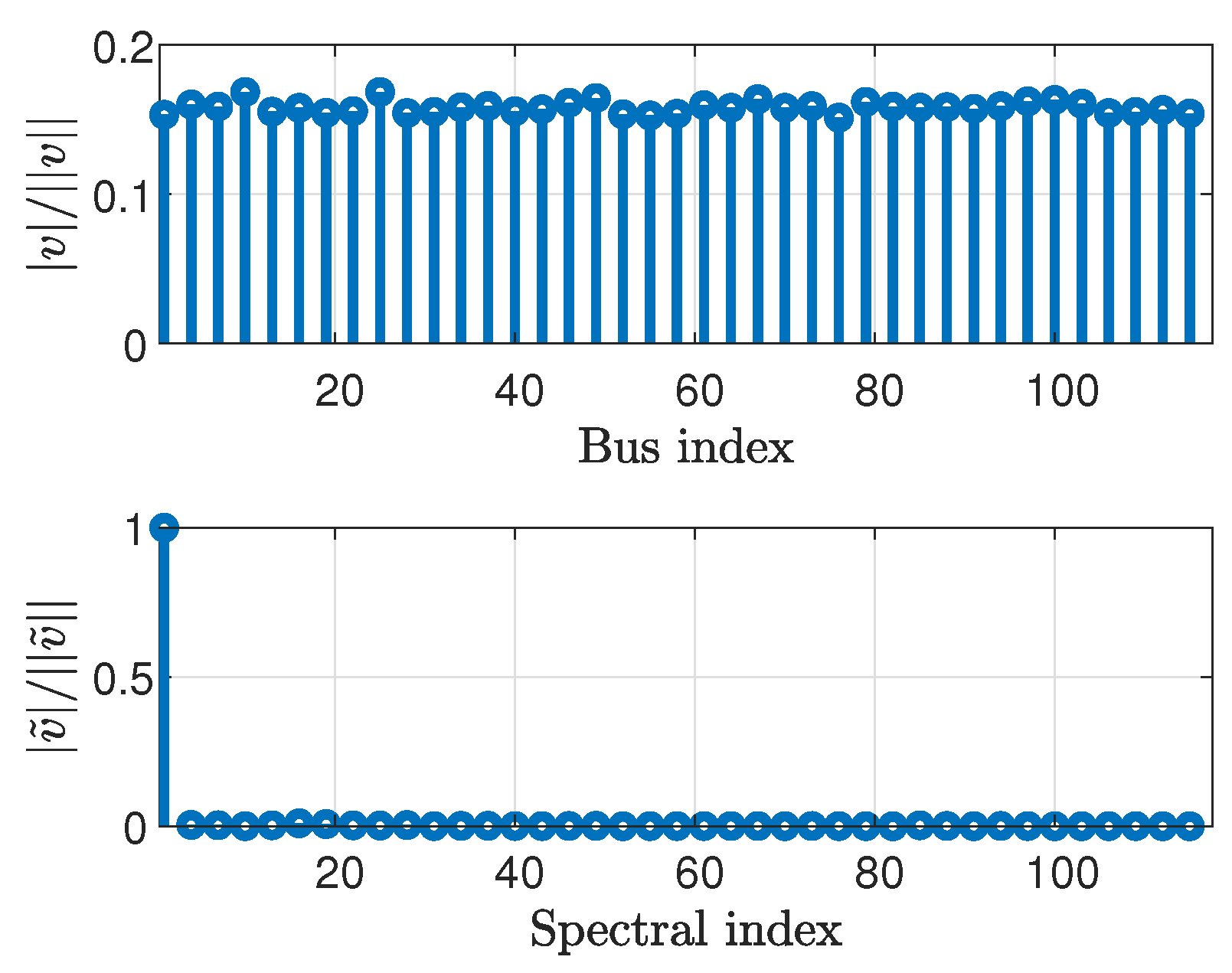
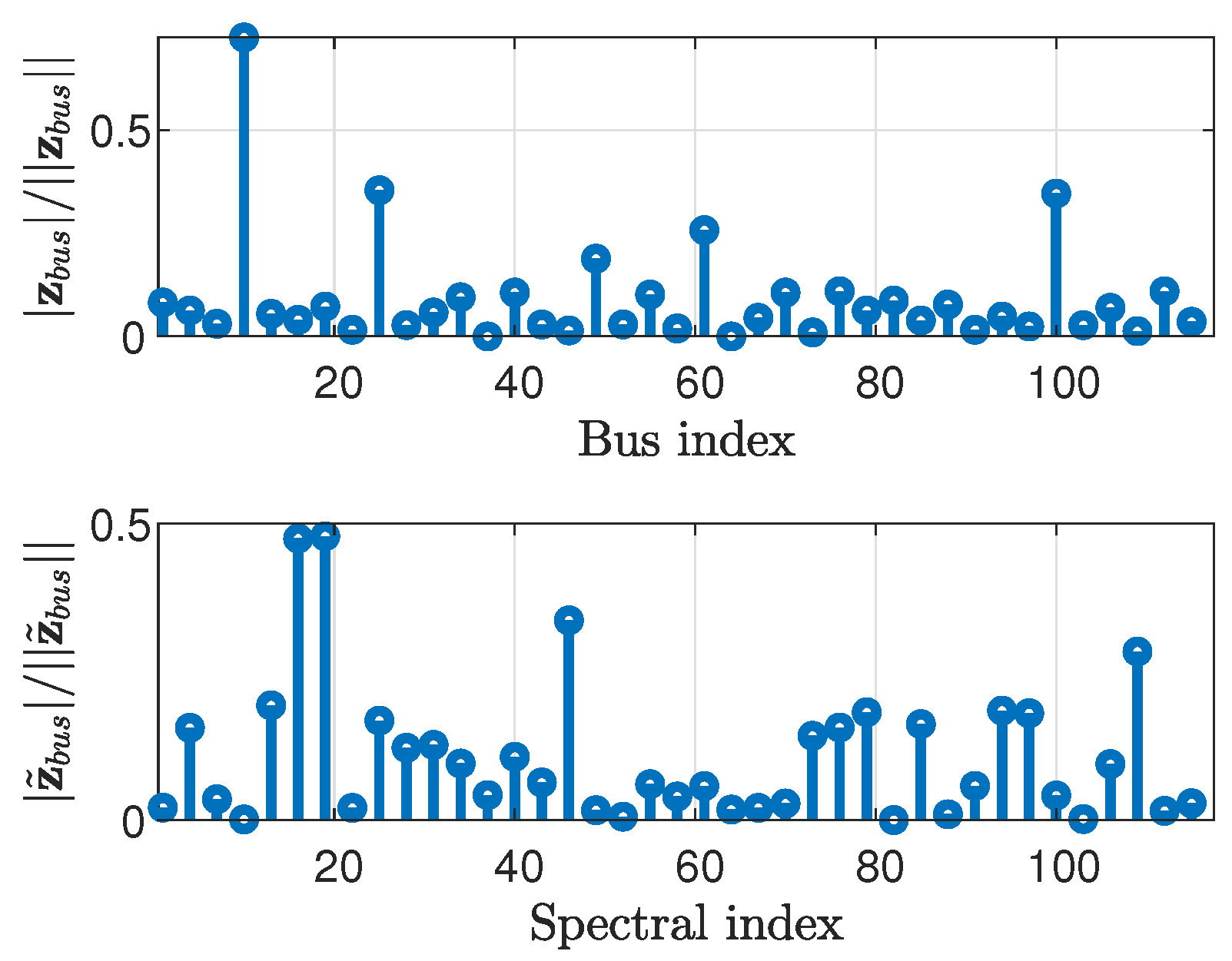
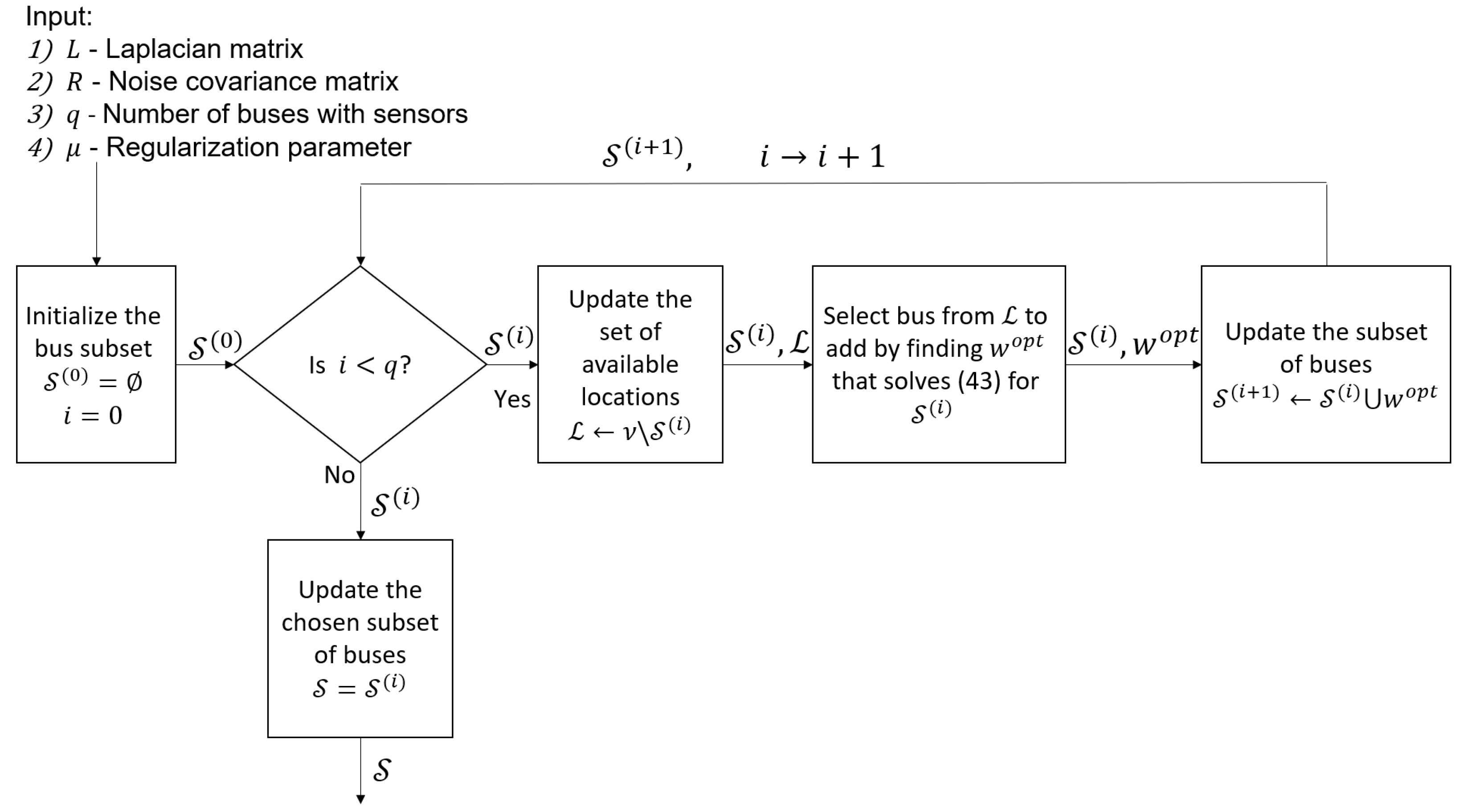

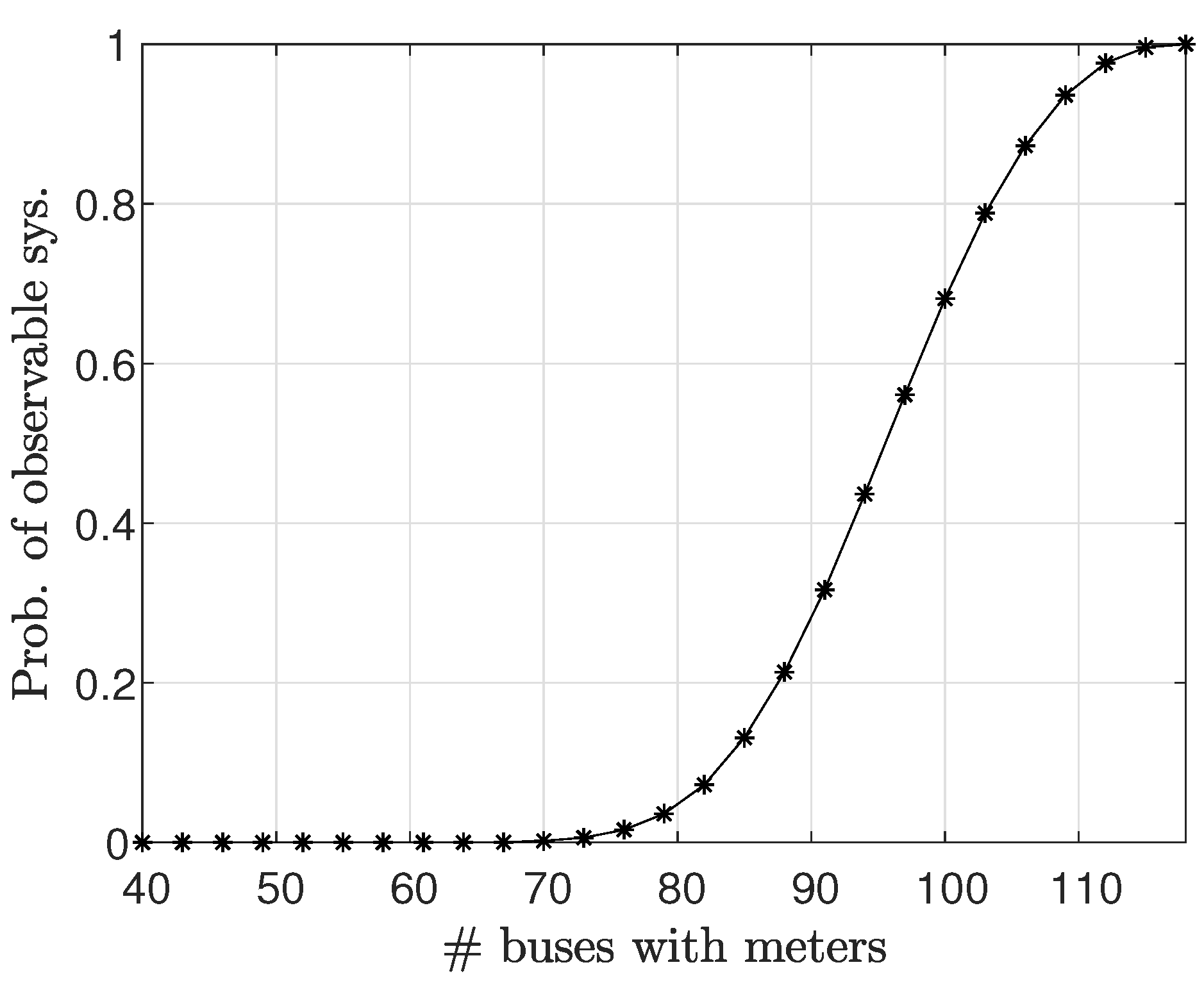

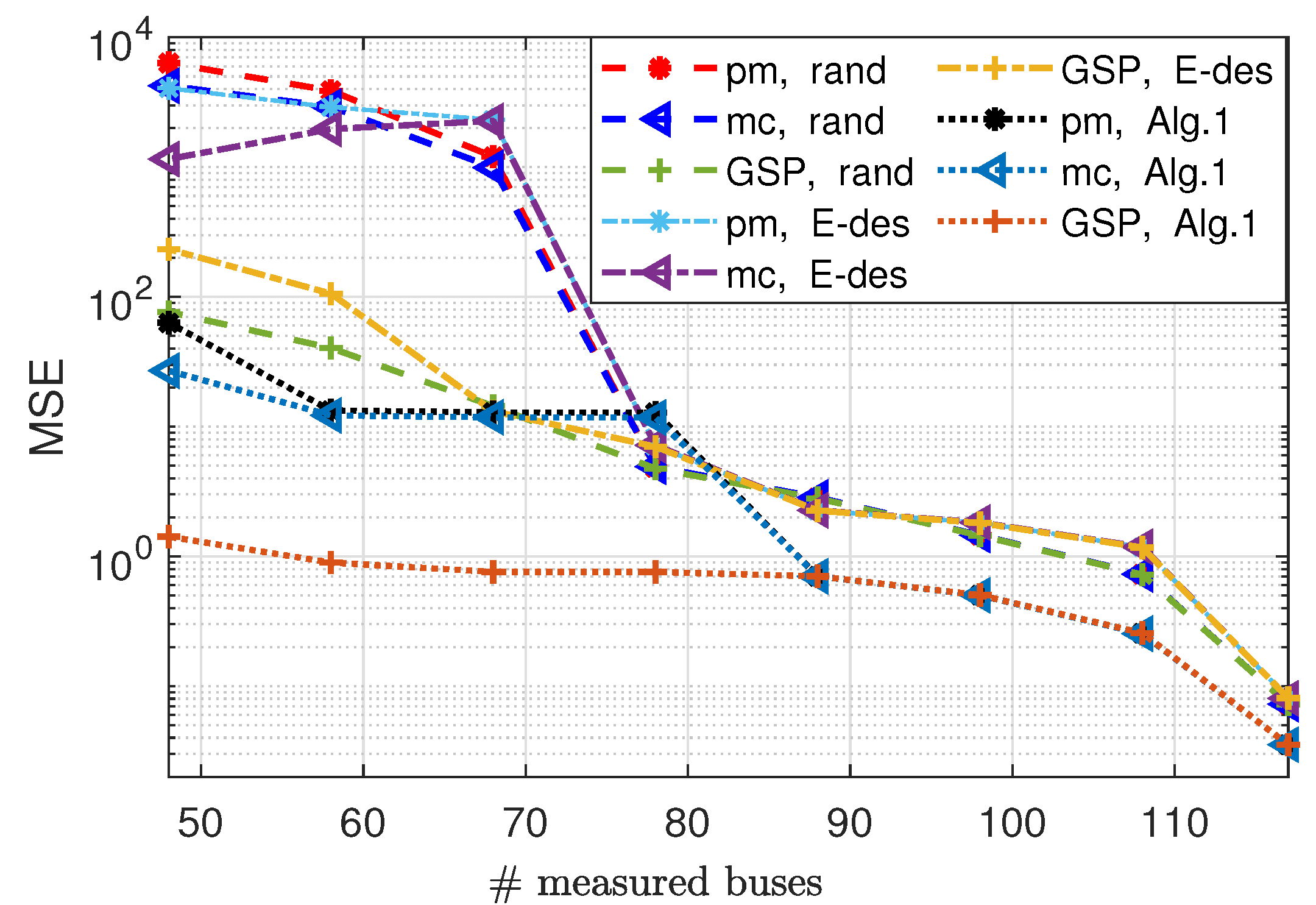
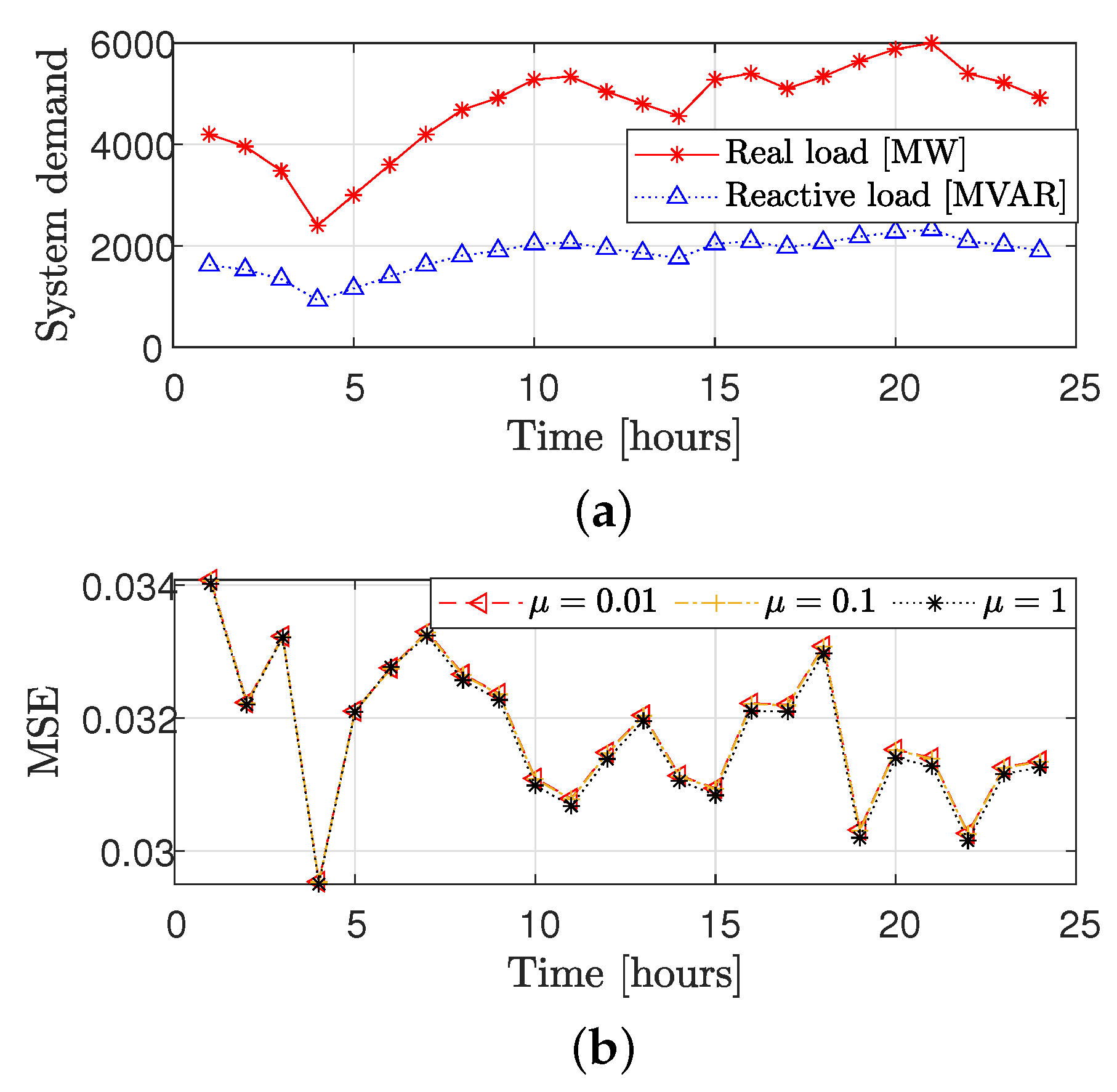
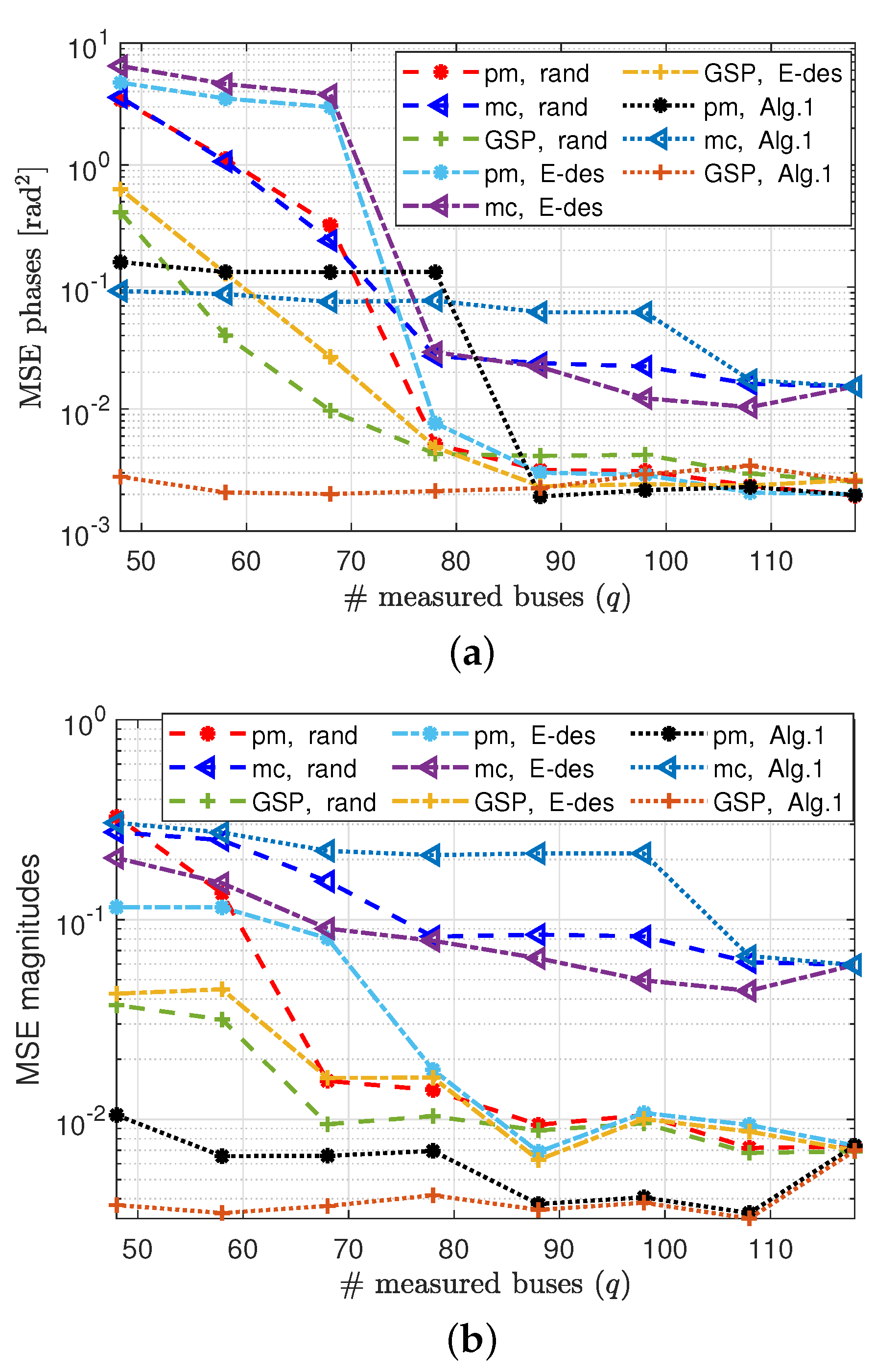
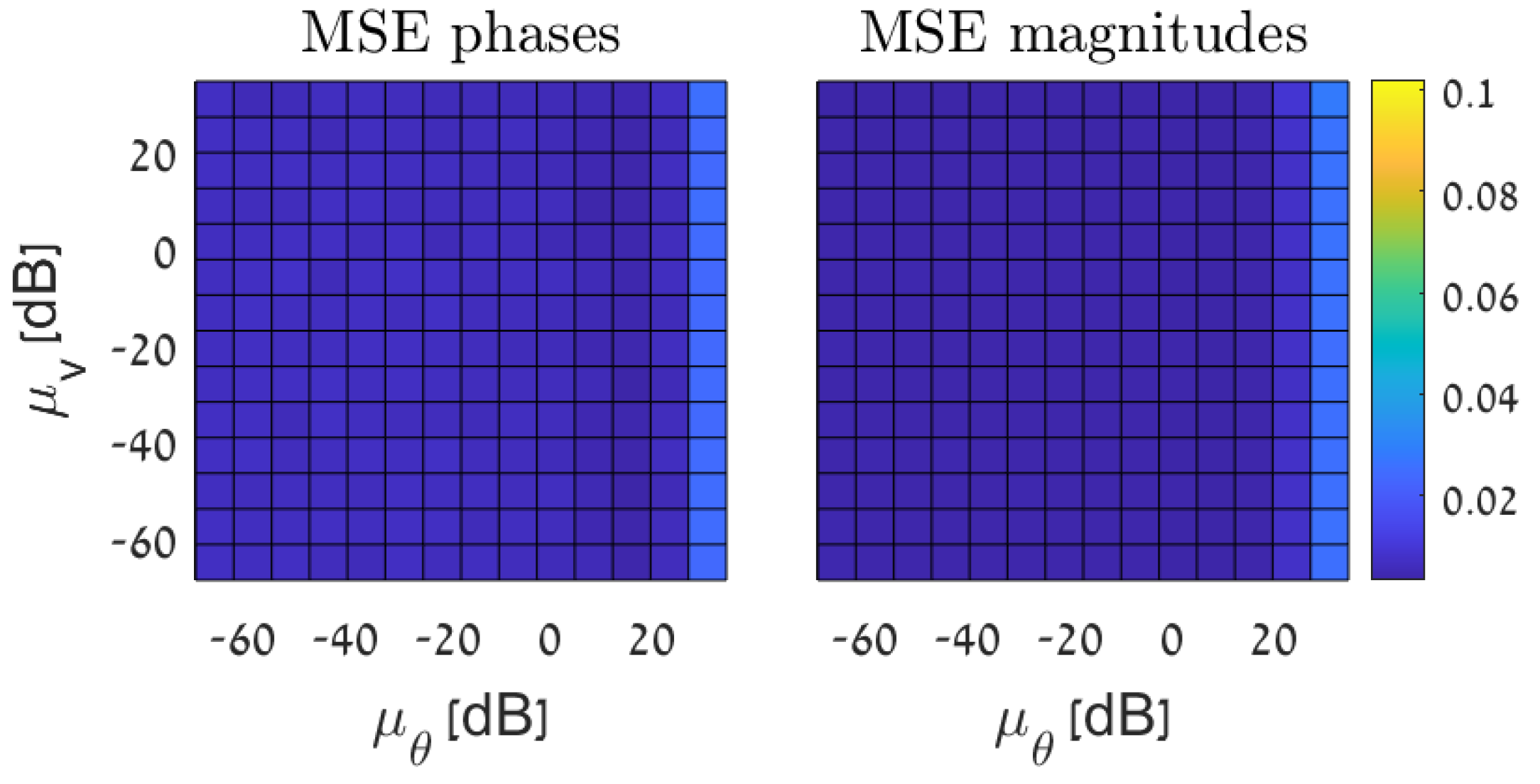

| Measure | IEEE Test Case System | ||||
|---|---|---|---|---|---|
| 14-Bus | 30-Bus | 57-Bus | 118-Bus | 300-Bus | |
| 0.6617 | 0.3015 | 0.3714 | 1.1740 | 1.2371 | |
| 0.0036 | 0.0022 | 0.008 | 0.0082 | 0.0199 | |
| 16.4079 | 18.3307 | 50.8035 | 56.1047 | 138.8024 | |
Disclaimer/Publisher’s Note: The statements, opinions and data contained in all publications are solely those of the individual author(s) and contributor(s) and not of MDPI and/or the editor(s). MDPI and/or the editor(s) disclaim responsibility for any injury to people or property resulting from any ideas, methods, instructions or products referred to in the content. |
© 2023 by the authors. Licensee MDPI, Basel, Switzerland. This article is an open access article distributed under the terms and conditions of the Creative Commons Attribution (CC BY) license (https://creativecommons.org/licenses/by/4.0/).
Share and Cite
Dabush, L.; Kroizer, A.; Routtenberg, T. State Estimation in Partially Observable Power Systems via Graph Signal Processing Tools. Sensors 2023, 23, 1387. https://doi.org/10.3390/s23031387
Dabush L, Kroizer A, Routtenberg T. State Estimation in Partially Observable Power Systems via Graph Signal Processing Tools. Sensors. 2023; 23(3):1387. https://doi.org/10.3390/s23031387
Chicago/Turabian StyleDabush, Lital, Ariel Kroizer, and Tirza Routtenberg. 2023. "State Estimation in Partially Observable Power Systems via Graph Signal Processing Tools" Sensors 23, no. 3: 1387. https://doi.org/10.3390/s23031387
APA StyleDabush, L., Kroizer, A., & Routtenberg, T. (2023). State Estimation in Partially Observable Power Systems via Graph Signal Processing Tools. Sensors, 23(3), 1387. https://doi.org/10.3390/s23031387






